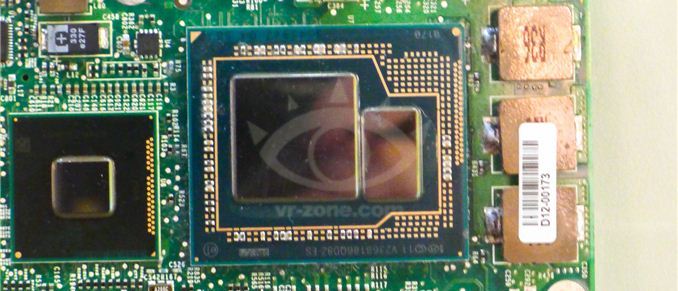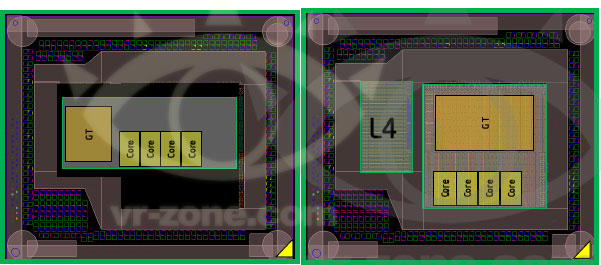Intel's Return to DRAM: Haswell GT3e to Integrate 128MB eDRAM?
by Anand Lal Shimpi on April 23, 2013 11:58 AM EST
We've known for a while now that Intel will integrate some form of DRAM on-package for the absolute highest end GPU configurations of its upcoming Haswell SoC. Memory bandwidth is a very important enabler of GPU (and multi-core CPU) performance, but delivering enough of it typically required very high speed interfaces (read: high power) and/or very wide interfaces (read: large die areas). Neither of the traditional approaches to scaling memory bandwidth are low power or cost effective, which have kept them out of ultra mobile and integrated processor graphics.
The days of simple performance scaling by throwing more transistors at a design are quickly coming to an end. Moore's Law will continue but much like the reality check building low power silicon gave us a while ago, building high performance silicon will need some out of the box thinking going forward.
Dating back to Ivy Bridge (3rd gen Core/2012), Intel had plans to integrate some amount of DRAM onto the package in order to drive the performance of its processor graphics. Embedding DRAM onto the package adds cost and heat, and allegedly Paul Otellini wasn't willing to greenlight the production of a part that only Apple would use so it was canned. With Haswell, DRAM is back on the menu and this time it's actually going to come out. We've referred to the Haswell part with embedded DRAM as Haswell GT3e. The GT3 refers to the GPU configuration (40 EUs), while the lowercase e denotes embedded DRAM. Haswell GT3e will only be available in a BGA package (soldered-on, not socketed), and is only expected to appear alongside higher TDP (read: not Ultrabook) parts. The embedded DRAM will increase the thermal load of the SoC, although it shouldn't be as painful as including a discrete GPU + high speed DRAM. Intel's performance target for Haswell GT3e is NVIDIA's GeForce GT 650M.
What we don't know about GT3e is the type, size and speed of memory that Intel will integrate. Our old friend David Kanter at RealWorldTech presented a good thesis on the answers to those questions. Based on some sound logic and digging through the list of papers to be presented at the 2013 VLSI Technology Symposium in Kyoto, Kanter believes that the title of this soon to be presented Intel paper tells us everything we need to know:
"A 22nm High Performance Embedded DRAM SoC Technology Featuring Tri-Gate Transistors and MIMCAP COB"
According to Kanter's deductions (and somewhat validated by our own sources), Haswell GT3e should come equipped with 128MB of eDRAM connected to the main SoC via a 512-bit bus. Using eDRAM vs. commodity DDR3 makes sense as the former is easier to integrate into Intel's current fabs. There are also power, manufacturability and cost concerns as well that resulted in the creation of Intel's own DRAM design. The interface width is a bit suspect as that would require a fair amount of area at the edges of the Haswell die, but the main takeaway is that we're dealing with a parallel interface. Kanter estimates the bandwidth at roughly 64GB/s, not anywhere near high-end dGPU class but in the realm of what you can expect from a performance mainstream mobile GPU. At 22nm, Intel's eDRAM achieves a density of around 17.5Mbit/mm^2, which works out to be ~60mm^2 for the eDRAM itself. Add in any additional interface logic and Kanter estimates the total die area for the eDRAM component to be around 70 - 80mm^2. Intel is rumored to be charging $50 for the eDRAM adder on top of GT3, which would deliver very good margins for Intel. It's a sneaky play that allows Intel to capture more of the total system BoM (Bill of Materials) that would normally go to a discrete GPU company like NVIDIA, all while increasing utilization of their fabs. NVIDIA will still likely offer better perfoming solutions, not to mention the benefits of much stronger developer relations and a longer history of driver optimization. This is just the beginning however.

Based on leaked documents, the embedded DRAM will act as a 4th level cache and should work to improve both CPU and GPU performance. In server environments, I can see embedded DRAM acting as a real boon to multi-core performance. The obvious fit in the client space is to improve GPU performance in games. At only 128MB I wouldn't expect high-end dGPU levels of performance, but we should see a substantial improvement compared to traditional processor graphics. Long term you can expect Intel to bring eDRAM into other designs. There's an obvious fit with its mobile SoCs, although there we're likely talking about something another 12 - 24 months out.
AMD is expected to integrate a GDDR5 memory controller in its future APUs, similar to what it has done with the PlayStation 4 SoC, as its attempt to solve the memory bandwidth problem for processor based graphics.
Source: RealWorldTech










83 Comments
View All Comments
r3loaded - Tuesday, April 23, 2013 - link
This chip has 13 inch retina MacBook Pro written all over it. Apple must have had some input on it.tipoo - Tuesday, April 23, 2013 - link
But from the leaks the TDP of the Haswell parts with GT3e is too high for the 13" Macbooks. I would love to see it in there, but I would guess it's just getting GT2.KaarlisK - Tuesday, April 23, 2013 - link
Where do they put the IVR (integrated voltage regulator) on the GT3e Haswell, or is it absent?tipoo - Tuesday, April 23, 2013 - link
I'd like to know if the CPU can dip into the eDRAM as a L4 cache of sorts if the GPU is underused or disabled. It would be a shame to waste that huge eDRAM die right beside the processor if the GPU goes unused.Quizzical - Tuesday, April 23, 2013 - link
This doesn't make a bit of sense. If the primary purpose is to be L4 cache for the CPU and boost performance that way, then why not make it available in desktop and server chips, which would offer far more plausible benefits than laptops?And if the primary purpose is to be GPU memory bandwidth, then why 128 MB? I could see big benefits to having the heavily-accessed depth buffer and frame buffer in cache, but at 1080p, those are a tad under 8 MB each. Maybe you want to put extra frame buffers there, for use in post-processing or to have both the front and back frame buffers cached. But that's not going to get you anywhere near 128 MB, and if it's for graphics, you're going to end up using most of that space for lightly accessed textures where it doesn't matter.
Surely they're not planning on moving the really heavily used stuff that doesn't take much space and currently goes in GPU cache to slower eDRAM. That would be as dumb as making an Intel i740 without dedicated video memory because they want to use slower system memory instead.
glugglug - Tuesday, April 23, 2013 - link
It's not for frame buffers, as you said, those are much smaller, and are most assuredly already in the GPU.The bandwidth is needed for accessing textures without pulling them from RAM each time. And yes, it does matter for the textures, in a huge way.
Quizzical - Tuesday, April 23, 2013 - link
Do tell how you propose to stick an 8 MB frame buffer in < 1 MB of L2 cache. For comparison, a Radeon HD 7970 has 768 KB of L2 cache, a Radeon HD 7870 has 512 KB, and a GeForce GTX 680 has 512 KB. Older or lower end cards tend to have less yet.And the L1 and L2 caches are presumably needed for smaller but more frequently accessed data such as program binaries and uniforms that are needed at every single shader invocation throughout the graphics pipeline.
tipoo - Tuesday, April 23, 2013 - link
Clearly it does make a difference, as GPUs accessing the system DDR memory take a huge performance penalty. Otherwise why would GPU makers strap on so much memory?Quizzical - Tuesday, April 23, 2013 - link
Yes, accessing textures from video memory rather than having to pass it through a PCI Express bus does make a big difference. But if you want to do that, you have to have enough video memory to actually store all of your textures in video memory. That's why modern video cards nearly always come with at least 1 GB and often more. 128 MB would let you stick a small fraction of your textures and vertex data in it, but nowhere near all of it except at low texture resolutions or in older games where you don't need much video memory.If textures are the goal, you'd likely see more benefit from adding a third channel of system memory, which lets you use a few GB if you need to. And while hardly cheap, that might well be cheaper than 128 MB of eDRAM.
Haydon987 - Sunday, April 28, 2013 - link
For modern graphical purposes, I have to agree, I don't see the point of adding 128MB of eDRAM. If it is for textures, any 3d game made in the last decade uses a few hundred MB, if not well over 1GB in some cases, at any reasonable resolution.I really only see this being useful as a cache for the CPU or for 2D applications.